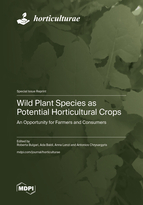Wild Plant Species as Potential Horticultural Crops: An Opportunity for Farmers and Consumers
A special issue of Horticulturae (ISSN 2311-7524).
Deadline for manuscript submissions: closed (31 May 2023) | Viewed by 21099
Special Issue Editors
Interests: horticulture; abiotic stress; biostimulant; soilless cultivation; microgreens; vegetable quality; ornamentals; postharvest quality
Special Issues, Collections and Topics in MDPI journals
Interests: vegetable crops; ornamentals; soilless cultivation; microgreens; baby leaf; vegetable quality; wild food plants
Interests: vegetable and ornamental crops; hydroponics; urban agriculture; vegetables quality and safety
Interests: aromatic plants and vegetable cultivation; development of strategies for plant nutrition and response to abiotic stress; soil-less culture, substrates and hydroponics; postharvest storage and processing of medicinal and aromatic plants; essential oil analysis and biocidal activity; evaluation of natural products
Special Issues, Collections and Topics in MDPI journals
Special Issue Information
Dear Colleagues,
There are about 30,000 plant species that are considered edible, but nowadays very few of them are crops grown or cultivated on a commercially significant scale. On the other hand, there are several plants or their parts (leaves, shoots, fruits, seeds, hypogeal organs, and flowers) that are collected in the wild and consumed as raw or cooked food. Ethnobotany may offer a source of inspiration for agriculture, as wild edible species have the potential to lead food systems to be healthier, more sustainable, and resilient to climate change. A good tolerance to several abiotic and biotic stresses, as well as a high nutritional value and excellent nutraceutical properties, are common traits of wild plants, making them promising candidates as new crops. Novel approaches for the outdoor/indoor cultivation of wild or underutilized species are needed to give new opportunities for the growers to produce new food categories, particularly appealing to modern consumers. Cultivating wild species is also a way to preserve ethnobotanical heritage and to promote genetic diversity. Furthermore, the cultivation of food plants usually gathered in the wild could reduce the health-related risks associated with pollution and biological contaminations.
The present Special Issue welcomes original research and reviews.
Dr. Roberta Bulgari
Dr. Ada Baldi
Dr. Anna Lenzi
Dr. Antonios Chrysargyris
Guest Editors
Manuscript Submission Information
Manuscripts should be submitted online at www.mdpi.com by registering and logging in to this website. Once you are registered, click here to go to the submission form. Manuscripts can be submitted until the deadline. All submissions that pass pre-check are peer-reviewed. Accepted papers will be published continuously in the journal (as soon as accepted) and will be listed together on the special issue website. Research articles, review articles as well as short communications are invited. For planned papers, a title and short abstract (about 100 words) can be sent to the Editorial Office for announcement on this website.
Submitted manuscripts should not have been published previously, nor be under consideration for publication elsewhere (except conference proceedings papers). All manuscripts are thoroughly refereed through a single-blind peer-review process. A guide for authors and other relevant information for submission of manuscripts is available on the Instructions for Authors page. Horticulturae is an international peer-reviewed open access monthly journal published by MDPI.
Please visit the Instructions for Authors page before submitting a manuscript. The Article Processing Charge (APC) for publication in this open access journal is 2200 CHF (Swiss Francs). Submitted papers should be well formatted and use good English. Authors may use MDPI's English editing service prior to publication or during author revisions.
Keywords
- edible species
- cultivation systems
- yield and quality
- new functional foods
- nutrients
- secondary metabolites
- antioxidants
- food security
- food safety
- biodiversity









